In the competitive world of digital marketing, creating high-quality SEO content that ranks well on search engines is crucial. With the introduction of DeepSeek AI, a cutting-edge artificial intelligence model, writing impactful, authentic, and SEO-friendly articles has become easier than ever. This tutorial will guide you through a step-by-step process to create content that not only ranks but also resonates with your audience, using DeepSeek AI.
Understanding DeepSeek AI and Its Benefits
DeepSeek AI is a powerful AI model developed to rival top-tier tools like OpenAI’s GPT. Designed to be free and highly efficient, it empowers users to craft articles that sound natural, deliver value, and drive organic traffic. With its ability to process vast amounts of data and generate human-like text, DeepSeek AI offers a unique advantage for content creators seeking to elevate their SEO game.
Key benefits include:
- Faster content creation.
- Natural, engaging tone.
- High relevance to search queries.
- Enhanced SEO potential with proper keyword integration.
In this guide, we’ll explore how to leverage these benefits step-by-step.
Step 1: Preparation – Laying the Groundwork
Before you start generating content with DeepSeek AI, preparation is essential. Here are the key elements to focus on:
1.1 Define Your Topic
Choose a topic that aligns with your niche and is relevant to your audience. For instance, if your website focuses on technology, you might write about “How DeepSeek AI Transforms SEO Content Creation.” Ensure the topic is trending or evergreen to maximize its long-term impact.
1.2 Conduct Keyword Research
Keywords are the backbone of SEO. Use tools like AnswerThePublic or Ahrefs to identify questions and phrases people are searching for related to DeepSeek AI. For example:
- What is DeepSeek AI?
- How does DeepSeek AI compare to OpenAI’s GPT?
- Is DeepSeek AI free to use?

Keep your focus on keywords that can be seamlessly integrated into your content without compromising readability.
1.3 Gather Research
Research is the foundation of valuable content. Compile reliable sources that provide insights into your topic. For instance, if writing about DeepSeek R1, gather information on its features, functionality, and real-world applications. Tools like Perplexity AI can help streamline your research process.
Step 2: Crafting the Perfect AI Prompt
To generate high-quality content, crafting a detailed and clear prompt for DeepSeek R1 is critical. Here’s an example:
- Topic: “How DeepSeek R1 Revolutionizes SEO Content Writing”
- Keywords: DeepSeek R1, SEO, AI content writing, organic traffic
- Research: Include a summary of key facts and figures about DeepSeek R1.
- Tone: Conversational and professional.
- Word Count: 1,500+ words.
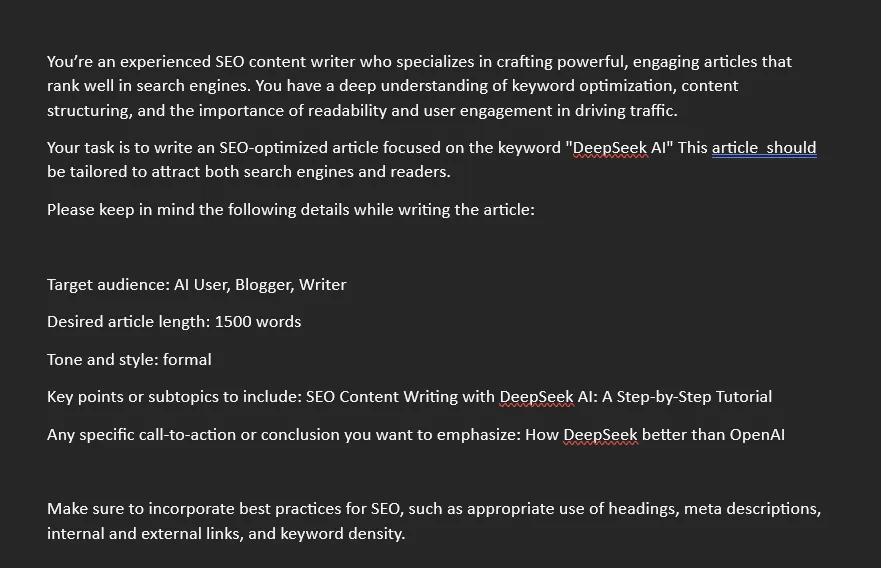
When inputting your prompt into DeepSeek R1, ensure it includes these details. This level of specificity will help the AI generate focused and accurate content.
Step 3: Generating Content with DeepSeek AI
Once your prompt is ready, feed it into DeepSeek R1. Watch as the AI processes your input and begins generating text. The output will often include a strong introduction, clear structure, and well-integrated keywords.
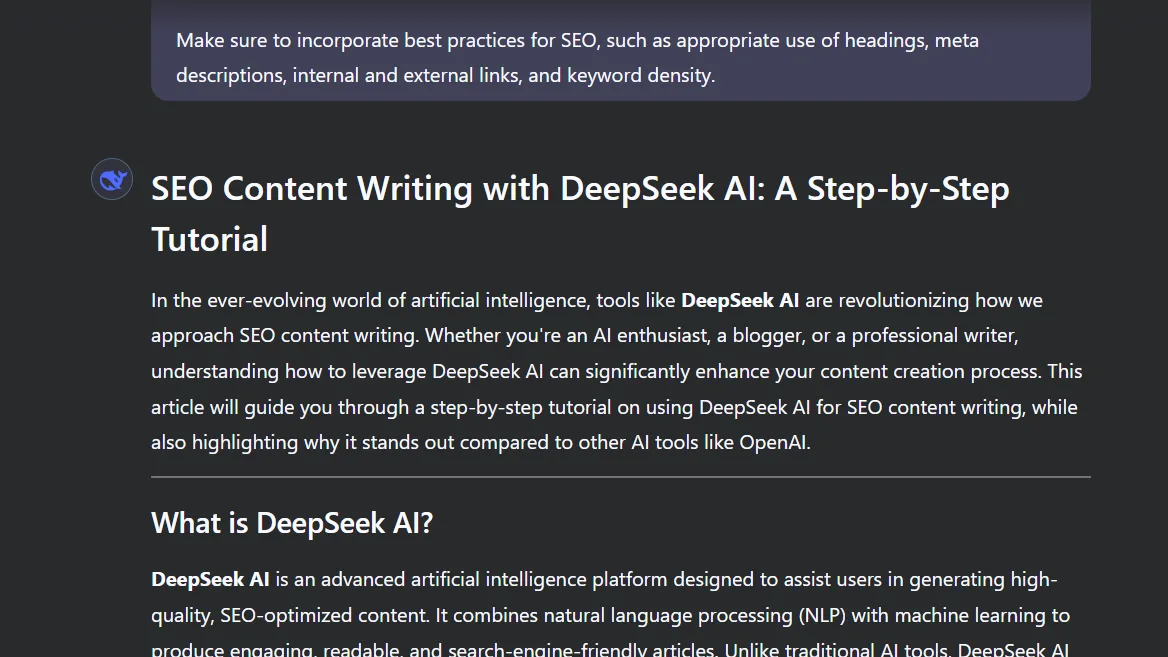
Tips for Refining the Output
- Edit for Readability: Review the AI-generated content to ensure it flows naturally and aligns with your brand voice.
- Add Visuals: Break up the text with relevant images, charts, or infographics to enhance understanding and engagement.
- Ensure Accuracy: Cross-check facts and data against your research.
Step 4: Polishing the Article for SEO
A polished article is essential for SEO success. Here’s how to refine your content:
4.1 Optimize Meta Elements
Create a compelling meta title and description that includes your main keyword. For example:
- Title: “DeepSeek R1: Transforming SEO Content Creation for Organic Growth”
- Meta Description: “Discover how DeepSeek R1 simplifies SEO content writing, driving long-term organic traffic with smart AI technology.”
4.2 Add Internal and External Links
Internal links connect your article to other relevant pages on your site, boosting SEO. External links to credible sources add authority. For example:
- Link to your previous article on AI tools.
- Cite a study or report about AI technology.

4.3 Enhance with Multimedia
Use tools like Napkin AI to create visuals. Convert images to lightweight formats like WebP to improve site speed. For example:
- An infographic comparing DeepSeek R1 to other AI models.
- A chart showing how DeepSeek R1 improves organic traffic over time.
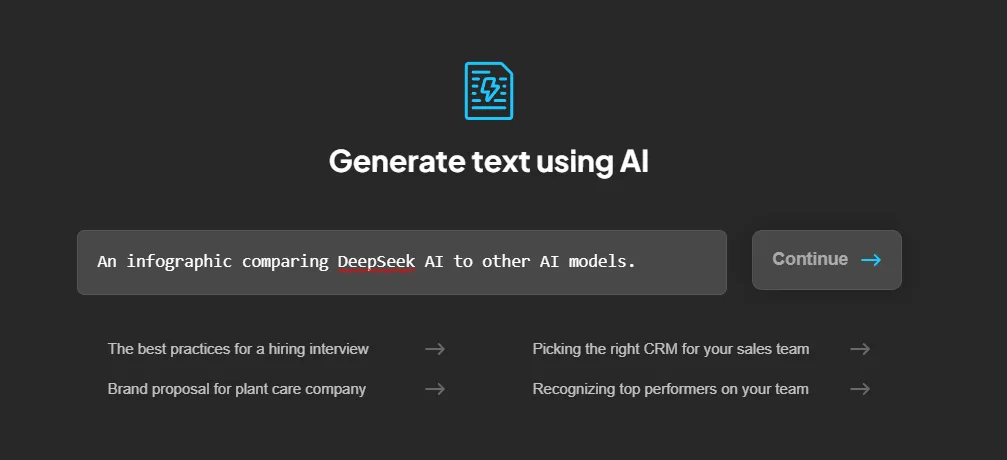
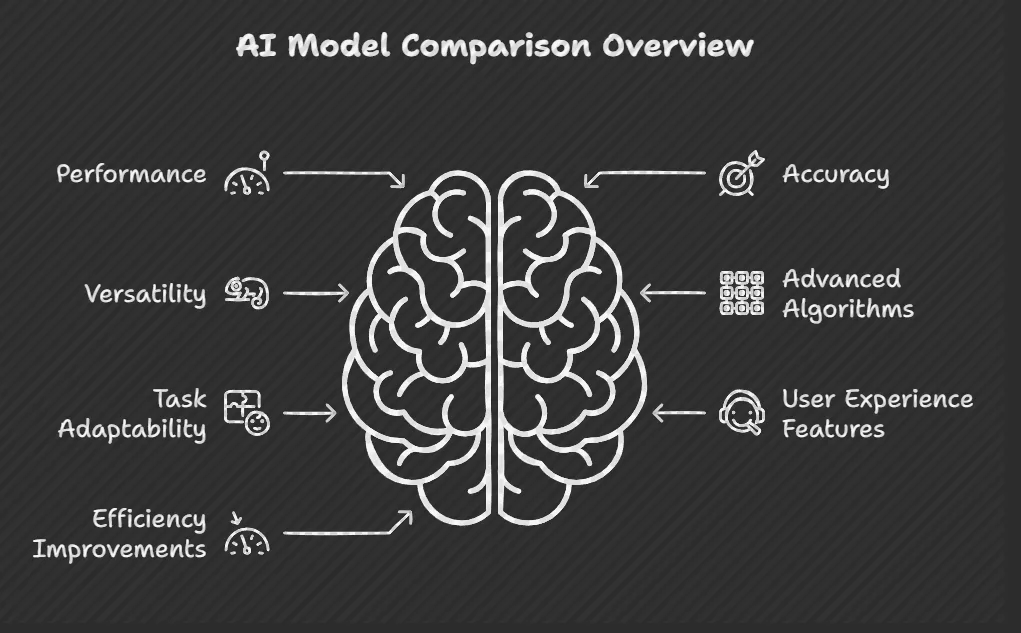
Step 5: Publishing and Indexing
After finalizing your article, it’s time to publish it. Follow these steps:
5.1 Publish on Your CMS
Whether you use WordPress, Webflow, or another platform, ensure your article is well-formatted. Pay attention to:
- Headings: Use H1 for the title and H2/H3 for subheadings.
- Images: Optimize alt text with keywords.
- Tables: Use HTML for clean formatting if necessary.
5.2 Submit to Google Search Console
Submit your article’s URL to Google Search Console to expedite indexing. This step signals Google to crawl and rank your content faster.
Step 6: Promoting Your Content
To maximize reach, share your article across multiple platforms:
- Social Media: Post on LinkedIn, Twitter, and Facebook.
- Video Platforms: Create a short video summarizing the article for YouTube or TikTok.
- Email Marketing: Include the article in your newsletter.
Sharing your content widely generates positive engagement signals, which boost your SEO ranking.
Step 7: Analyzing Performance
Monitor your article’s performance using tools like Google Analytics. Track metrics such as:
- Traffic: How many visitors are reading your article.
- Engagement: Time spent on the page.
- Conversions: Leads or sales generated from the article.
Use this data to refine your content strategy for future articles.
How DeepSeek AI Outperforms OpenAI
While OpenAI’s GPT models are powerful, DeepSeek AI offers several features that make it a better choice for SEO content writing:
- SEO-Specific Tools: DeepSeek AI includes built-in SEO optimization tools, whereas OpenAI requires additional plugins or manual adjustments.
- Greater Customization: DeepSeek AI allows users to fine-tune content parameters, ensuring the output matches their specific needs.
- Cost Efficiency: DeepSeek AI’s pricing plans are more affordable, making it accessible to a wider audience.
- User Support: DeepSeek AI provides dedicated customer support, helping users maximize the platform’s potential.
Conclusion
DeepSeek AI is a game-changer for anyone involved in SEO content writing. Its advanced features, user-friendly interface, and cost-effective solutions make it a superior choice compared to OpenAI. By following the step-by-step tutorial outlined in this article, you can harness the power of DeepSeek AI to create content that ranks well, engages readers, and drives traffic to your website.
Ready to take your content creation to the next level? Try DeepSeek AI today and experience the difference for yourself!
What is DeepSeek AI, and how does it work?
DeepSeek AI is an advanced artificial intelligence platform designed to assist users in creating high-quality, SEO-optimized content. It uses natural language processing (NLP) and machine learning to generate engaging, readable, and search-engine-friendly articles. Users input their topic and keywords, customize content parameters, and receive a draft that can be further refined for SEO and readability.
How is DeepSeek AI different from OpenAI?
DeepSeek AI stands out from OpenAI due to its SEO-specific features, greater customization options, and cost-effective pricing. Unlike OpenAI, DeepSeek AI includes built-in SEO tools, such as keyword optimization and meta description suggestions, making it a more tailored solution for content creators focused on search engine rankings.
Can DeepSeek AI help with keyword optimization?
Yes, DeepSeek AI is specifically designed to assist with keyword optimization. It suggests optimal keyword density (1-2%), incorporates long-tail keywords, and ensures that keywords are naturally integrated into the content. Additionally, it provides recommendations for meta descriptions and internal linking to improve SEO performance.
Is DeepSeek AI suitable for beginners?
Absolutely! DeepSeek AI features a user-friendly interface that makes it accessible for beginners while offering advanced customization options for experienced users. Its step-by-step content generation process and built-in SEO tools simplify the content creation process, even for those new to SEO writing.
How does DeepSeek AI improve content readability and engagement?
DeepSeek AI enhances readability by generating content with clear structure, short paragraphs, and engaging subheadings. It also allows users to customize the tone and style of the content to match their target audience. By focusing on user engagement and SEO best practices, DeepSeek AI ensures that the content not only ranks well but also resonates with readers.
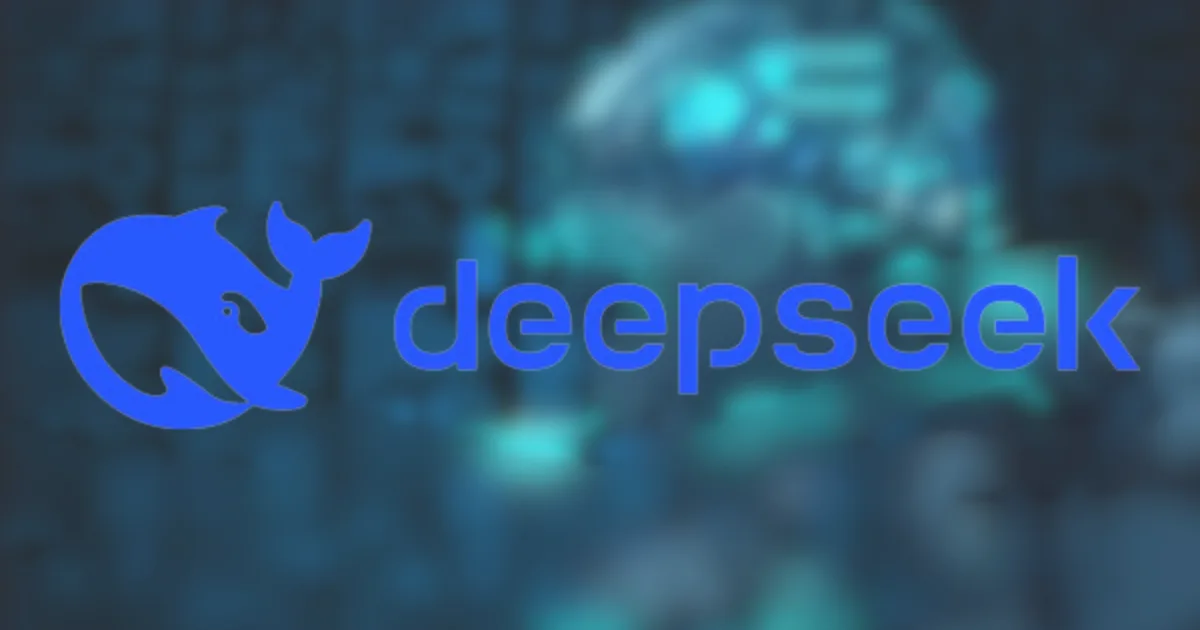


Comment:
This is a fantastic guide to mastering SEO content writing with DeepSeek AI.
The detailed, step-by-step approach makes it easy for anyone to understand and implement the
strategies for creating high-quality, SEO-friendly content.
I particularly appreciate the emphasis on keyword research, crafting the perfect AI prompt, and optimizing meta elements for SEO.
The comparison between DeepSeek AI and OpenAI’s GPT is also enlightening, highlighting the unique features and benefits of DeepSeek AI for SEO content writing.
The tutorial provides a comprehensive overview of the platform’s capabilities and how to use them to improve search
engine rankings and drive organic traffic.
I’m excited to try DeepSeek AI for my own content creation and see the results for myself.
Thank you for sharing this valuable resource!